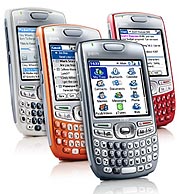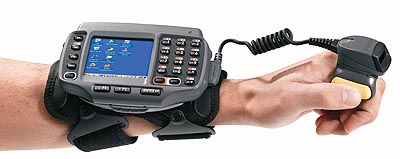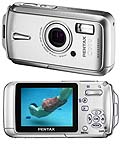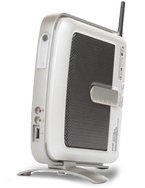October 2006
Panasonic updates bestselling Toughbook models
Panasonic introduced two rugged Panasonic Toughbook computers: The CF-19 convertible Tablet PC, and the flagship CF-30 clamshell notebook. Building on the CF-18 tablet and CF-29 notebook, the new models come with Intel Core Duo processors, additional security features, and optional next-generation wireless data networks from all major cellular wireless carriers. In addition to the usual magnesium alloy cases, sealed keyboards and ports, flexible internal connectors and shock-mounting, Panasonic claims the brightest displays available today, without compromising battery life. The CF-19 has a bright 550 Nit screen with a new low-reflection coating and the CF-30 an industry-leading 1,000 Nit LCD. The new models are backwards compatible with existing vehicle mounts, protecting the investments of existing Toughbook owners. With battery life of approximately 6 hours, the units are tested to withstand drops, shocks, vibration and extremes in temperature, and carry an IP54 rating. Look for detailed reviews of both units soon. -- Posted Tuesday, October 31, 2006
HP iPAQ 6900 Series
 It's taken a good long while, but the HP iPAQ 6900 series of Pocket PC phones will start selling through Cingular by the end of the month. An advanced version of the HP 6300 we reviewed and used a good while ago, the 6920/6925 is powered by a 416MHz PXA270, has a 3-inch 240x240 display (we had hoped for 480x480 by now!), quad band telephony (GSM/GPRS/EDGE), WiFi, Bluetooth, GPS -- all in a 2.8 x 4.7 x 0.7 inch package that weighs 6.3 ounces. There's a full QWERTY thumbtype keyboard and the 6925 version also has a 1.3mp camera. -- Posted Tuesday, October 31, 2006
It's taken a good long while, but the HP iPAQ 6900 series of Pocket PC phones will start selling through Cingular by the end of the month. An advanced version of the HP 6300 we reviewed and used a good while ago, the 6920/6925 is powered by a 416MHz PXA270, has a 3-inch 240x240 display (we had hoped for 480x480 by now!), quad band telephony (GSM/GPRS/EDGE), WiFi, Bluetooth, GPS -- all in a 2.8 x 4.7 x 0.7 inch package that weighs 6.3 ounces. There's a full QWERTY thumbtype keyboard and the 6925 version also has a 1.3mp camera. -- Posted Tuesday, October 31, 2006
Afaria 5.5 enhances wireless mobile security
Sybase iAnywhere announced Afaria 5.5, the next generation of the company's award-winning frontline management and security solution. Afaria 5.5 includes new capabilities to initially provision devices over wireless networks, expanded device security functionality, remote control for Windows Mobile devices, and expanded Patch Manager capabilities. Afaria Security Manager has also been updated to include FIPS 140-2 compliant encryption modules, which ensures corporations can safely extend sensitive data to mobile professionals and meet security directives and compliance requirements. [Afaria 5.5 new features -- Posted Tuesday, October 31, 2006
Syware Visual CE 10 sets milestone
SYWARE, a developer of mobile database development tools for business and personal productivity, today announced the world wide release of Visual CE 10, a major new release of its award winning mobile database development tool. The new release significantly extends the capabilities of Visual CE and its drag-and-drop desktop development environment, which enables both business professionals and developers to easily create Windows Mobile based applications with little or no programming. [see complete list of enhancements] -- Posted Monday, October 30, 2006
Syware Visual CE 10 sets milestone
SYWARE, a developer of mobile database development tools for business and personal productivity, today announced the world wide release of Visual CE 10, a major new release of its award winning mobile database development tool. The new release significantly extends the capabilities of Visual CE and its drag-and-drop desktop development environment, which enables both business professionals and developers to easily create Windows Mobile based applications with little or no programming. [see complete list of enhancements] -- Posted Thursday, October 26, 2006
Microsoft seeks to double WinMo Smartphones from 6 to 12 million this year
According to Reuters, Microsoft aims to double the number of mobile phones running its software this year from 6 million at the end of 2005 and to keep up this rate of growth in coming years. This is based on a statement Peter Knook, head of Microsoft's Mobile and Embedded Devices division, made to Germany's Euro am Sonntag. As is, Nokia has about half the global market for smartphones. As a value-added, Microsoft is looking at ways to connect users of Windows Mobile smartphones to its Xbox Live online video games console, thus adding to their appeal. -- Posted Monday, October 23, 2006
Palm announces sleek Treo 680 "world phone"
 Palm announced the Palm Treo 680 smartphone, a GSM/GPRS/EDGE quad-band world phone that is smaller and sleeker than prior Treos (4.4 x 2.3 x 0.8, weighing 5.5 ounces) and comes in a variety of colors (Graphite, Crimson, Arctic, and Copper). The 680 runs Palm OS 5.4.9 on a 312MHz PXA270 processor, has a 320x320 screen, includes 64MB of user-available storage, nearly three times the memory of the original Treo 650 smartphone. Customers can add up to 2GB of storage with expansion cards. There is enhanced email and messaging; SMS, MMS and the Blazer browser have been improved; there is enhanced multimedial the 680 can be used as a wireless modem via Bluetooth 1.2. The Treo 680 also can be used as an MP3 player and has an integrated 640 x 480 digital camera, camcorder and video player. [see Palm's Treo 680 page] -- Posted Thursday, October 12, 2006
Palm announced the Palm Treo 680 smartphone, a GSM/GPRS/EDGE quad-band world phone that is smaller and sleeker than prior Treos (4.4 x 2.3 x 0.8, weighing 5.5 ounces) and comes in a variety of colors (Graphite, Crimson, Arctic, and Copper). The 680 runs Palm OS 5.4.9 on a 312MHz PXA270 processor, has a 320x320 screen, includes 64MB of user-available storage, nearly three times the memory of the original Treo 650 smartphone. Customers can add up to 2GB of storage with expansion cards. There is enhanced email and messaging; SMS, MMS and the Blazer browser have been improved; there is enhanced multimedial the 680 can be used as a wireless modem via Bluetooth 1.2. The Treo 680 also can be used as an MP3 player and has an integrated 640 x 480 digital camera, camcorder and video player. [see Palm's Treo 680 page] -- Posted Thursday, October 12, 2006
PalmSource changes name to ACCESS
In addition to unveiling a new logo today at the annual ACCESS Day in Tokyo, ACCESS announced that its wholly-owned subsidiary, PalmSource, Inc., is in the process of changing its company name to ACCESS. The ACCESS press release says "Together, ACCESS and PalmSource are committed to developing products and platforms designed to optimize the capabilities of mobile phones and devices. The first product to leverage the collective technologies and expertise of ACCESS and PalmSource is the ACCESS Linux Platform (ALP), announced in February 2006." Check the new ACCESS website. -- Posted Thursday, October 12, 2006
Waterproof USB Flash drives
Kingston Technology introduced a new line of rugged, waterproof USB 2.0 Flash drives capable of withstanding harsh operating conditions. The new DataTraveler Secure line of USB drives feature titanium-coated stainless steel casings that are waterproof to depths up to four feet. The drives are available in capacities up to 4 GB and will start at a MSRP of US$33 for a 512MB version. -- Posted Wednesday, October 11, 2006
Smart phone and PDA sales rising
CNET cites Gartner stats according to which smart phones abd PDA sales are growing rapidly. Smart phone sales grew 75.5% to 37.4 million in 2005, and are expected to grow another 66% this year. PDA sales are much lower, in the 7 million a year rangee, and are growing by single digits. Distinction between the two is increasingly difficult. Gartner defines a smart phone as "a large-screen, voice-centric handheld device designed to offer complete phone functions while simultaneously functioning as a personal digital assistant." It defines a PDA as "a handheld computer that serves as an organizer and electronic notepad." This makes it difficult to classify what is what as more and more PDAs include cellphone capability. In addition, it's becoming tough to figure out which of the almost one billion cellphones sold a year are "smart." Overall, Gartner predicts over 100 million smart phones and almost 16 million PDAs in 1006. -- Posted Tuesday, October 10, 2006
Symbol introduces wearable with handmount scanner

Symbol introduced the WT4000 Series of wearable terminals. The smartly designed device measures just 5.7 x 3.7 x 1 inches and weighs 11.3 ounces with a full-shift battery. The PXA270-powered WT4000 is geared towards warehousing and manufacturing markets, has 128MB of RAM and 64MB of flash, uses Windows CE 5.0 Pro and has a transflective 2.8" LCD. It is used with either the RS309 Wearable Scanner that's worn on the back of the hand or an even lighter and handier option, the RS409 Ring Scanner. Both use a 650nm laser and can read and decode virtually all 1D symbologies. The WT4000 and the scanners are sealed to IP54 specifications and can survive four-foot drops. [See our preview of the Symbol WT4000]
-- Posted Tuesday, October 10, 2006
Something different: a waterproof digicam with an IP58 rating!
 Not exactly a PDA or mobile device, but a fun, cool toy nonetheless: a little digital camera that not only doesn't mind the occasional splash, no, you can swim and even dive with it! See our sister site's review of the handy 6-megapixel Pentax Optio W10 digital camera with an interal 3X optical zoom. It looks just like a regular digital camera and is as small and light as one, but it can handle five feet of water for 30 minutes. Which means you can probably take it deeper than that. Enough for snorkling, tide pools, around lakes and even diving in rivers. [See review of the waterproof Pentax Optio W10.] -- Posted Friday, October 6, 2006
Not exactly a PDA or mobile device, but a fun, cool toy nonetheless: a little digital camera that not only doesn't mind the occasional splash, no, you can swim and even dive with it! See our sister site's review of the handy 6-megapixel Pentax Optio W10 digital camera with an interal 3X optical zoom. It looks just like a regular digital camera and is as small and light as one, but it can handle five feet of water for 30 minutes. Which means you can probably take it deeper than that. Enough for snorkling, tide pools, around lakes and even diving in rivers. [See review of the waterproof Pentax Optio W10.] -- Posted Friday, October 6, 2006
Wyse debuts new high-speed wireless thin clients
 Wyse Technology announced the industry's first family of Via C3-based high-speed Wi-Fi enabled thin clients that, when turned on, automatically and securely connect to any supported wireless network, without requiring driver installation or assembly. Compatible with Microsoft Terminal Services, Citrix Presentation Server, VMware VDI and Wyse Device Manager, the line includes models based on Windows CE 5 (Wyse V30), Linux (Wyse V50) and Windows XP embedded (Wyse V90). There is support for WPA and WPA2 for use with 802.1x authentication. The devices measure 7.9 x 7.1 x 1.8 inches, weigh about 8 pounds, and have various mounting options (horizontal, vertical, brackets). -- Posted Wednesday, October 4, 2006
Wyse Technology announced the industry's first family of Via C3-based high-speed Wi-Fi enabled thin clients that, when turned on, automatically and securely connect to any supported wireless network, without requiring driver installation or assembly. Compatible with Microsoft Terminal Services, Citrix Presentation Server, VMware VDI and Wyse Device Manager, the line includes models based on Windows CE 5 (Wyse V30), Linux (Wyse V50) and Windows XP embedded (Wyse V90). There is support for WPA and WPA2 for use with 802.1x authentication. The devices measure 7.9 x 7.1 x 1.8 inches, weigh about 8 pounds, and have various mounting options (horizontal, vertical, brackets). -- Posted Wednesday, October 4, 2006
Is there life for RIM beyond wireless email?
Our friends at VDC recently participated in RIMís Analyst Summit and left the briefings with the notion that RIM clearly understood its position and role within the industry and what they need to do to continue to expand their footprint. While RIMís success so far has been well documented, the fact remains that their installed base of approximately 6 million users represents the tip of the mobile worker iceberg. Enterprise mobility remains very much in its infancy with organizations only starting to begin to understand the implications of wireless data applications. In other words, as enterprise applications continue to go mobile, can RIM leverage its first-mover advantage in wireless e-mail? Moreover, can RIM and its Blackberry platform continue to compete as the emphasis for enterprise adoption shifts away from wireless e-mail? [Read entire bulletin] -- Posted Monday, October 2, 2006
 It's taken a good long while, but the HP iPAQ 6900 series of Pocket PC phones will start selling through Cingular by the end of the month. An advanced version of the HP 6300 we reviewed and used a good while ago, the 6920/6925 is powered by a 416MHz PXA270, has a 3-inch 240x240 display (we had hoped for 480x480 by now!), quad band telephony (GSM/GPRS/EDGE), WiFi, Bluetooth, GPS -- all in a 2.8 x 4.7 x 0.7 inch package that weighs 6.3 ounces. There's a full QWERTY thumbtype keyboard and the 6925 version also has a 1.3mp camera. -- Posted Tuesday, October 31, 2006
It's taken a good long while, but the HP iPAQ 6900 series of Pocket PC phones will start selling through Cingular by the end of the month. An advanced version of the HP 6300 we reviewed and used a good while ago, the 6920/6925 is powered by a 416MHz PXA270, has a 3-inch 240x240 display (we had hoped for 480x480 by now!), quad band telephony (GSM/GPRS/EDGE), WiFi, Bluetooth, GPS -- all in a 2.8 x 4.7 x 0.7 inch package that weighs 6.3 ounces. There's a full QWERTY thumbtype keyboard and the 6925 version also has a 1.3mp camera. -- Posted Tuesday, October 31, 2006 Palm announced the Palm Treo 680 smartphone, a GSM/GPRS/EDGE quad-band world phone that is smaller and sleeker than prior Treos (4.4 x 2.3 x 0.8, weighing 5.5 ounces) and comes in a variety of colors (Graphite, Crimson, Arctic, and Copper). The 680 runs Palm OS 5.4.9 on a 312MHz PXA270 processor, has a 320x320 screen, includes 64MB of user-available storage, nearly three times the memory of the original Treo 650 smartphone. Customers can add up to 2GB of storage with expansion cards. There is enhanced email and messaging; SMS, MMS and the Blazer browser have been improved; there is enhanced multimedial the 680 can be used as a wireless modem via Bluetooth 1.2. The Treo 680 also can be used as an MP3 player and has an integrated 640 x 480 digital camera, camcorder and video player. [
Palm announced the Palm Treo 680 smartphone, a GSM/GPRS/EDGE quad-band world phone that is smaller and sleeker than prior Treos (4.4 x 2.3 x 0.8, weighing 5.5 ounces) and comes in a variety of colors (Graphite, Crimson, Arctic, and Copper). The 680 runs Palm OS 5.4.9 on a 312MHz PXA270 processor, has a 320x320 screen, includes 64MB of user-available storage, nearly three times the memory of the original Treo 650 smartphone. Customers can add up to 2GB of storage with expansion cards. There is enhanced email and messaging; SMS, MMS and the Blazer browser have been improved; there is enhanced multimedial the 680 can be used as a wireless modem via Bluetooth 1.2. The Treo 680 also can be used as an MP3 player and has an integrated 640 x 480 digital camera, camcorder and video player. [
 Not exactly a PDA or mobile device, but a fun, cool toy nonetheless: a little digital camera that not only doesn't mind the occasional splash, no, you can swim and even dive with it! See our sister site's review of the handy 6-megapixel Pentax Optio W10 digital camera with an interal 3X optical zoom. It looks just like a regular digital camera and is as small and light as one, but it can handle five feet of water for 30 minutes. Which means you can probably take it deeper than that. Enough for snorkling, tide pools, around lakes and even diving in rivers. [
Not exactly a PDA or mobile device, but a fun, cool toy nonetheless: a little digital camera that not only doesn't mind the occasional splash, no, you can swim and even dive with it! See our sister site's review of the handy 6-megapixel Pentax Optio W10 digital camera with an interal 3X optical zoom. It looks just like a regular digital camera and is as small and light as one, but it can handle five feet of water for 30 minutes. Which means you can probably take it deeper than that. Enough for snorkling, tide pools, around lakes and even diving in rivers. [ Wyse Technology announced the industry's first family of Via C3-based high-speed Wi-Fi enabled thin clients that, when turned on, automatically and securely connect to any supported wireless network, without requiring driver installation or assembly. Compatible with Microsoft Terminal Services, Citrix Presentation Server, VMware VDI and Wyse Device Manager, the line includes models based on Windows CE 5 (
Wyse Technology announced the industry's first family of Via C3-based high-speed Wi-Fi enabled thin clients that, when turned on, automatically and securely connect to any supported wireless network, without requiring driver installation or assembly. Compatible with Microsoft Terminal Services, Citrix Presentation Server, VMware VDI and Wyse Device Manager, the line includes models based on Windows CE 5 (